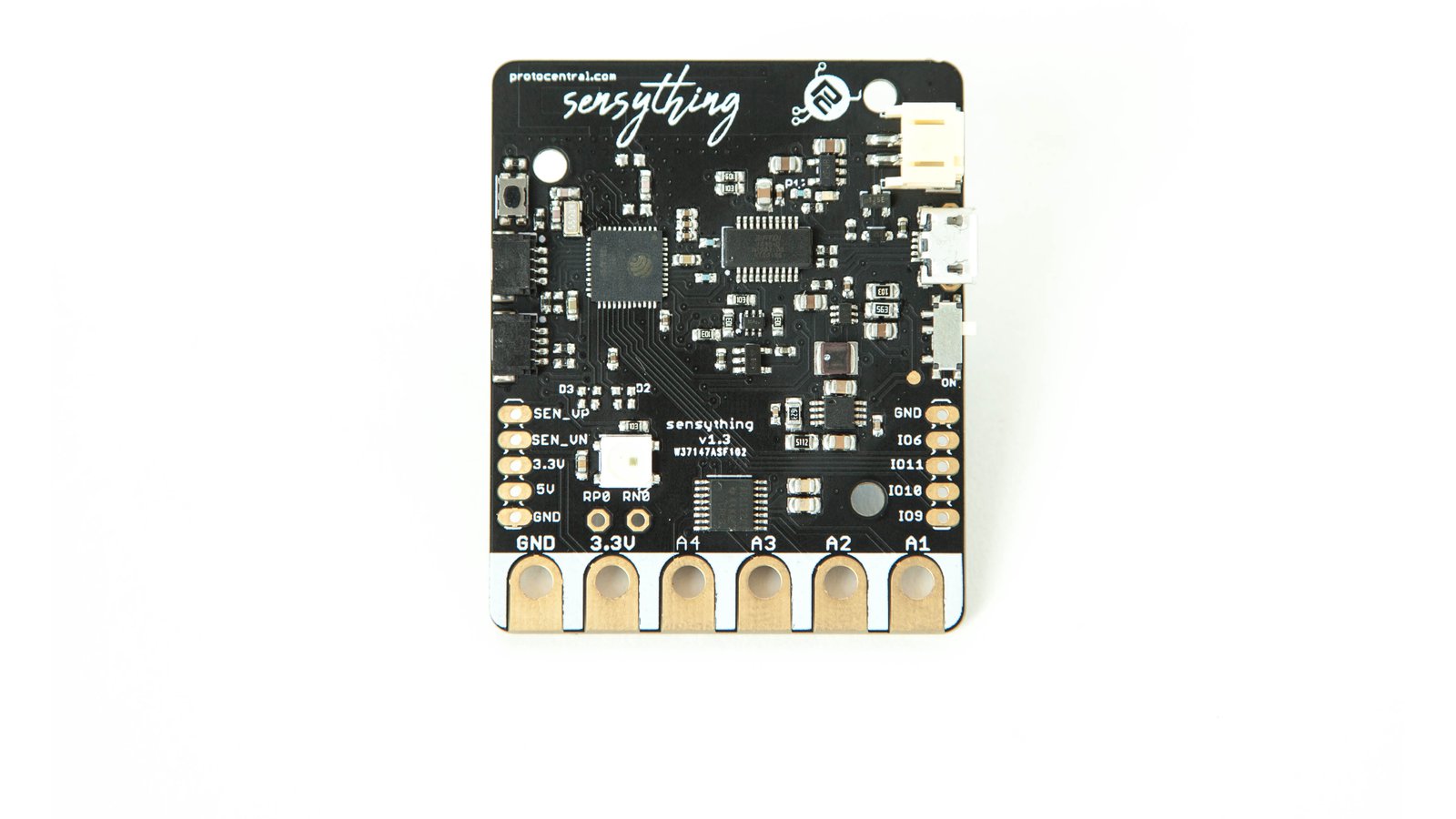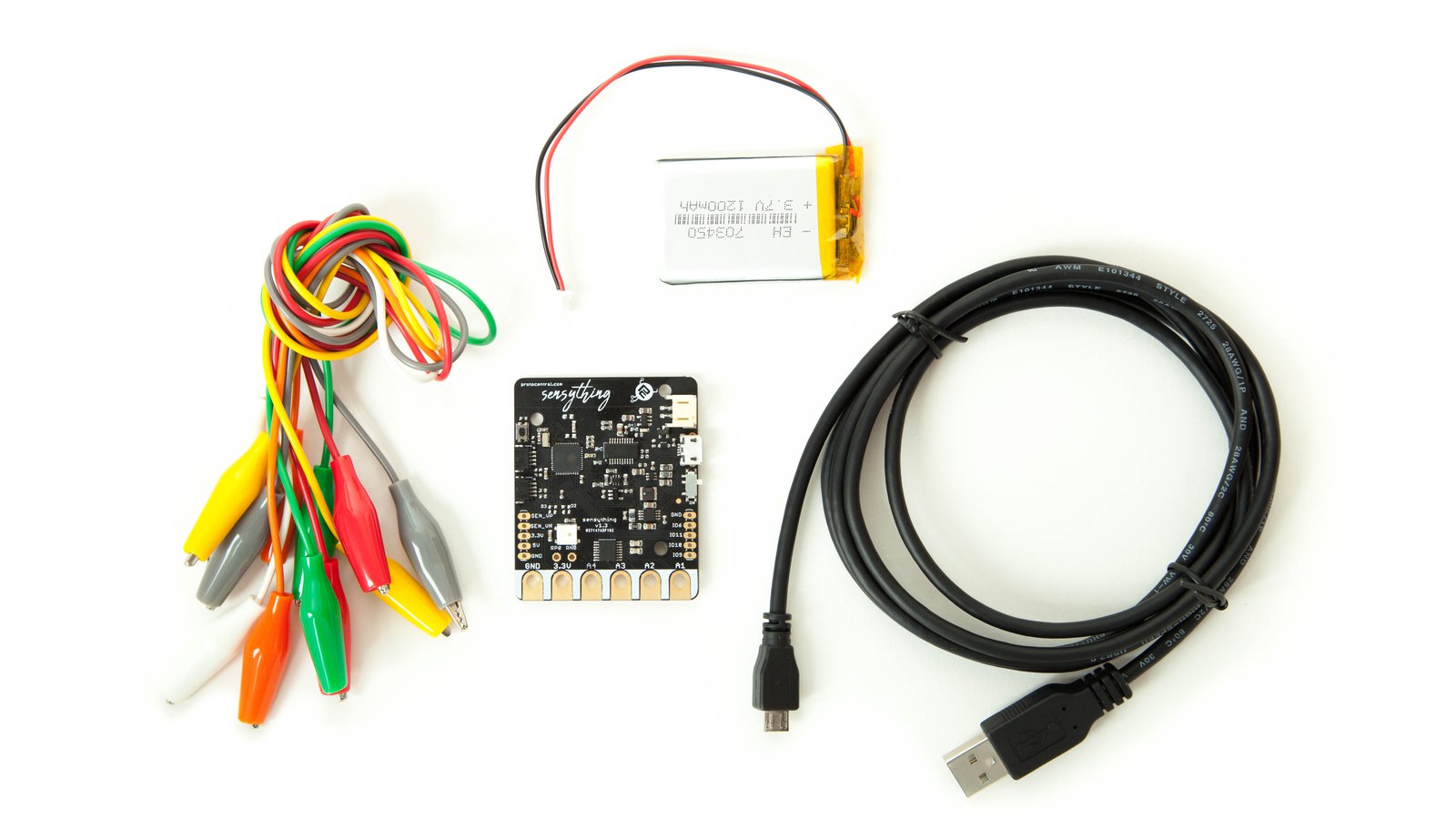ProtoCentral Electronics Private Limited
Microcontroller Boards
Bluetooth
ProtoCentral Electronics Private Limited
Microcontroller Boards
Bluetooth
Sensything is an open source, high-resolution (24-bit), Wi-Fi and Bluetooth-enabled sensor interface platform that supports multiple sensor readings. In most cases, it offers a single-board, single-platform solution for acquiring and logging multiple sensor readings that can be seen/sent through an Android app, an IoT or analytics platform, over an ordinary USB connection, or logged right to a microSD.
Curious citizen scientists all over the world want to detect, record, and monitor data from the environment in which they live. Recently, we’ve seen several stories of citizen scientists coming together on research projects. But all too often, these projects are limited by the available data-gathering tools and the difficulty of using them. This limits what citizen scientists can do.
Sensything aims to break these barriers by providing access to high-performance sensors that require only minimal electronics knowledge, while still providing all the features a serious hardware developer could want. With Sensything, you do not have to know how to interface multiple sensors, solder, or even breadboards to do citizen science or experiment and learn with Physical Computing. Just get hacking and measure what you want.
Sensything lets a biomedical engineer, a student, a scientist, or even a surgeon interface field-specific sensors with minimal effort. Before Sensything, prototyping something like this would involve multiple boards, sensors, and breakout boards along with the complexity involved in making all of these work together. Sensything eliminates all this complexity. Add to this the ability to connect to Wi-Fi or a Bluetooth App, and you can see how Sensything is a complete sensor-to-UI solution on a single board.
Sensything is based on the popular ESP32 SoC for IoT applications and includes the ADS1220 24-bit ADC that provides low-noise data acquisition. It provides all the accompanying components, including a Li-ion battery and an on-board,low-noise, five volt power source for reliable low-noise performance. Additionally, extra GPIO pins and support for Sparkfun’s Qwiic connector standard makes multi-modal sensor data fusion and recording easy.
| A. | ESP32 SoC | F. | USB |
| B. | Qwiic extension connectors | G. | Extra GPIO |
| C. | More inputs and power | H. | 24-bit ADC |
| D. | RGB LED | I. | Analog inputs |
| E. | Power for sensors |
ADC: Texas Instruments ADS1220 24-bit Sigma-Delta
The Qwiic connect system is Sparkfun’s contribution to making modern day prototyping more progressive. The focus was to develop a reliable and easier platform with notable performance. Sparkfun has sensors, actuators, shields, etc. that all make use of the I2C protocol. All components within this range can be connected by using Qwiic cables that come in different lengths. Sensors can also be connected in a daisy-chain to a single Qwiic connector.
With Sensything we have built-in support for popular Qwiic sensors. Device drivers will be updated for a list of sensors and they will be automatically loaded when the sensor gets plugged-in. That would certainly set the pace for new beginners who look for a simplified process to achieve results. Stay tuned for further updates to new sensors!
GitHub repo: https://github.com/Protocentral/protocentral_sensything Documentation: https://sensything.protocentral.com/
| Sensything | NI USB-6000 | Open DAQ | WiFi-500 Sensor Series | Bean Air | |
|---|---|---|---|---|---|
| Manufacturer | ProtoCentral | National Instruments | INGEN10 | Measurement Computing | Bean Air |
| Analog Channels | 4 single-ended/2 differential | 8 single-ended | 8 | 2 | 4 |
| Analog Resolution | 24-bit | 12-bit | 16-bit | ±0.6 °C | 16-bit |
| Open-ness | Open Source | Closed | Open Source | Closed | Closed |
| Supported Sensors | Analog, GPIO and I2C | Analog, Digital | Analog, Digital | Temperature, Humidity | Temperature, Humidity |
| Wi-Fi Connectivity | Yes | No | No | Yes | Yes |
| Bluetooth Connectivity | Yes | No | No | No | No |
| Other Connectivity | USB | USB | USB | USB, Cloud Storage | - |
| Sampling Rate | 10 SPS to 2000 SPS | 10 KSPS | 1000 SPS | 10 sec | 400 SPS |
| CPU | ESP32 | Unknown | 16 MHz ATmega 2560 | Unknown | Unknown |
| Input Range | ±0.01 V to ±2.5 V (adjustable gain) | ±10 V | Up to ±12 V | –20 °C to 60 °C (–4 °F to 140 °F) | 4.5 mV to 20 V |
| Price | $95 | $200 | $234 | $150 | $400 upwards |
Your board will come pre-loaded with firmware that provides basic BLE data acquisition. This program reads all four channels of the ADC and sends them through BLE. The companion Android app displays the values in the mV scale. This is the simplest way to use Sensything out of the box.
The Sensything app for Android is now available for download. Keep an eye on project updates for new revisions of the Android app!
If you need to see sensor values at given times or look at recorded sensor data, you do not have to install any additional software or apps. Simply program the device using a specific firmware and the Sensything immediately shows up as a connectable Wi-Fi access point. You can then connect your computer or mobile device to the "Sensything" Wi-Fi network, point your web browser to the "sensything.local" site and see your sensor data right on the page. This does not require any internet connection.
With the on-board USB-UART converter, programming the device is easy using the Espressif ESP-IDF and programming tools. You can write programs for the Sensything from within the Arduino IDE itself or, if you prefer more flexibility, with ESP-IDF. This also means that there is no end to what a skilled developer can do with Sensything.
We have our own low-volume manufacturing facility in Bangalore in India that can handle assembly as well as testing of the Sensything hardware. We also have our own team with testing and inspection expertise at our office/assembly facility in Bangalore, India.
Components for the Sensything are being sourced from well-known vendors including Espressif, TI, and Digi-Key. This includes even smaller components such as capacitors and resistors to ensure we get consistent signal quality and reproducibility of signals each time, every time. We have already successfully run, completed, and delivered the HealthyPi-v3 and the HeartyPatch campaigns right here on Crowd Supply.
We have been through several stages of prototyping as seen in the list of boards above. We’ve been through several iterations and made changes for various reasons to arrive at the perfect blend of performance and ease-of-use!
Due to the high cost of shipping and given the high volume of orders expected, the amazing people at Crowd Supply will be handling fulfilment. All orders will ship from Crowd Supply’s headquarters located in Portland, OR in the United States.
Please see the Crowd Supply Guide for more details or questions about shipping.
Customs import duty and taxes may apply for certain countries and certain customers. The customer is responsible for paying any import duties/taxes, if applicable.
Having our own production capability greatly reduces the risk associated with product QC and testing. If we exceed capacity, we have strong relationships with our reliable China-based assembly and production partners. Sensything’s four hardware iterations and repeated testing of the design with different components also contributes to the stability of the design.
That being said, hardware projects are always exposed to risks associated with component shortages, shipping delays, and equipment breakdown. We have also learnt from our previous projects about what factors cause delays and can preemptively take action. We will do our best to resolve such issues at the earliest and always keep you updated about any changes in our estimated schedule.
"The Sensything will come pre-loaded with firmware that provides simple BLE data gathering, which is gained through all four channels of the ADC and displays those values on an Android-based app."
"Engineers, developers and hobbyists may be interested in the new multi sensor development board called Sensything"
"Die Sensything-Platine basiert auf dem ESP32-SoC (System-on-a-Chip) und soll Citizen Science einfacher machen."
"[Sensything is] designed for multiple sensor’s analog and digital (I2C, GPIO) data acquisition, and designed around Espressif Systems ESP32 WiFi & Bluetooth SoC."
" The board is an almost complete setup for an IoT sensor. Just connect a sensor and you’ll be up and running"
Produced by ProtoCentral Electronics Private Limited in Bengaluru, India.
Sold and shipped by Crowd Supply.

Includes the Sensything fully-assembled PCB ONLY. DOES NOT include battery or cables.

Includes the Sensything fully-assembled PCB, 10x 2-ended alligator clip leads for connections to sensors, microUSB cable for charging and programming.

· Protocentral · protocentral · protocentral@mastodon.social · protocentral.com
ProtoCentral is an open-source hardware design, development, and manufacturing company based in India. We are strongly committed to the development of open source hardware. Most of our products are open source and anyone is free to re-use them for their own projects. We are also working toward open sourcing more hardware, especially for the medical and biotech domains.